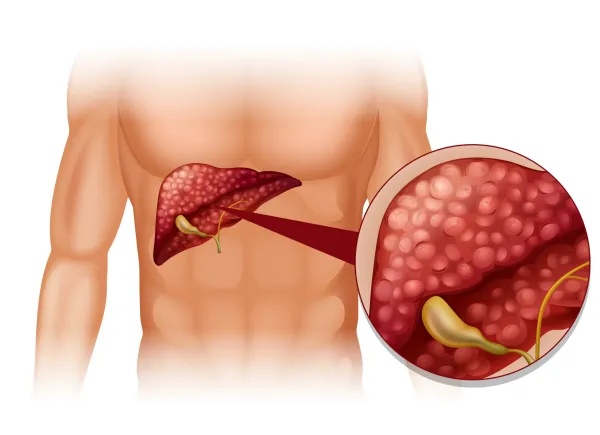Although early signs of fatty liver may be unidentifiable due to their symptomless nature, there may be some you start to notice overtime. Some people may experience vague signs like fatigue, unexpected weight changes or discomfort in the abdomen. In some cases, fatty liver can also show visible signs on your skin that can help you identify underlying issues with your liver. As you read, you will discover what are some common skin issues caused by fatty liver and how to manage these skin issues.
Common skin-related issues caused by fatty liver
1. Yellowing of skin and eyes
In more advanced stages of fatty liver, the fat buildup can lead to liver inflammation or damage. This reduces the liver's ability to process bilirubin (a yellow pigment from red blood cell breakdown). This can cause yellow discolouration in your skin and eyes.
2. Spider angiomas
Spider angiomas are tiny web-like blood vessels. Fatty liver can affect your hormones metabolism by increasing your oestrogen levels which can dilate small blood vessels under the skin. These can appear on your face, chest and arms.
3. Itchy skin
Liver dysfunction can cause bile salts in your body to buildup in the bloodstream which further iterates the nerve endings in your skin. Persistent itching on your skin without a visible rash which is often worse at night and on the palms and soles might be due to fatty liver.
4. Hyperpigmentation
Insulin resistance and inflammation from a fatty liver can often trigger melanin overproduction. This causes darkened, velvety skin in your skin folds, neck, armpits, etc.
5. Red palms
Altered hormone levels and vascular changes from liver strain can increase your blood flow to the skin. This may appear as persistent redness on the palms and can also be warm to touch.
6. Easy bruising
The liver produces clotting factors, when impaired, bruising can occur more easily even with minor bumps. Recent or large bruises without clear causes can be a sign of fatty liver.
Now that you can identify common signs on your skin of fatty liver, let's understand how to manage these signs.
Tips to manage skin issues caused by fatty liver
1. Improve liver health through diet
A nutrient-rich, anti-inflammatory diet is the foundation. Including plenty of vegetables, fruits, whole grains, legumes, lean proteins, and healthy fats can help. Avoid fried foods, processed snacks, excess sugar, and alcohol, as these worsen liver fat buildup.
2. Stay hydrated
Adequate water intake helps the liver flush out toxins and keeps the skin moisturised from within. Dehydration can make itching worse and emphasise dryness or flakiness.
3. Use gentle, non-toxic skincare
Liver dysfunction can make skin more sensitive to chemicals. Choose fragrance-free, alcohol-free cleansers, moisturisers, and sunscreens to avoid irritation. Avoid harsh exfoliants that can worsen redness or dryness.
4. Moisturise regularly
Bile salt buildup can lead to dry, itchy skin. Applying a thick, fragrance-free moisturiser after bathing locks in hydration. Ingredients like ceramides, glycerin, and colloidal oatmeal can calm inflammation and soothe itching.
5. Relieve itching with soothing baths
Oatmeal baths or lukewarm (not hot) water soaks can reduce pruritus. Hot water strips oils from the skin and may worsen itching. You can also add a few drops of coconut oil or use an aloe vera gel after bathing for extra soothing.
6. Manage blood sugar & hormones
Since insulin resistance can cause hyperpigmentation, controlling blood sugar through diet, exercise, and medical advice can lighten dark patches and prevent worsening.
7. Protect skin from sun damage
Fatty liver can make the skin more prone to damage and pigmentation changes. Use broad-spectrum SPF 30+ daily, wear hats, and choose breathable, UV-protective clothing to prevent discolouration and irritation.
9. Treat spider angiomas and redness gently
For spider-like blood vessels or red palms, avoid overheating and minimise alcohol, as both dilate blood vessels. Cooling gels, cold packs, or mild anti-inflammatory creams recommended by a dermatologist may help manage appearance and discomfort.
Skin changes are often a surface symptom of deeper liver issues. Regular check-ups, liver function tests, and adherence to prescribed treatments are essential for lasting skin improvement. Addressing the root cause will naturally lead to healthier-looking skin.
